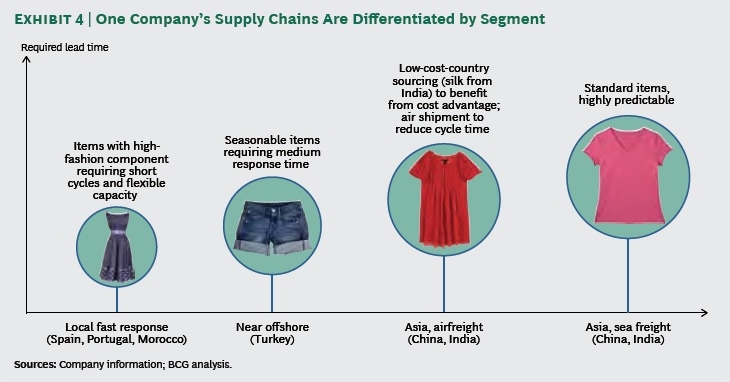While most discussions on improving corporate social responsibility practices in the apparel industry still focus on conventional solutions like higher labor standards and more effective monitoring programs, a recent Boston Consulting Group report suggests supply chain innovation also has its role to play.
One key argument of the report is: Although cost still matters in apparel sourcing, lower-cost can be achieved through means other than seeking cheap labor. For example:
Engendering end-to-end supply chain efficiency through managing raw materials. Apparel companies may work with their suppliers further down the supply chain to optimize fabric selection, which usually account for as much as 60-70 percent of the total cost of a finished garment (v.s. 30-40 percent of labor cost). Some apparel companies have started to use fewer yarns and weight classes so as to reduce fabric count and lower down sourcing cost. Some other companies are realizing significant cost reduction by timing orders so as to level the load over the course of the year. [Note: looks like Uniqlo’s model]
Building an integrated supply chain. As cited in the report, to balance sourcing cost and speed to market, one major apparel retailer builds 15 to 20 percent of the season’s styles and pre-positions about two-thirds of its raw material before the season (both in-house and from production partners). During the season, the company analyzes sales, staying in constant communication with its stores and with the design team. It resupplies items that are selling well through accelerated production and delivery, usually within three to four days. Designers then create new styles by adapting the best sellers using the pre-positioned material. [Note: looks like Zara’s model]
Innovating ways of production. The report suggests that bonding and gluing technologies (i.e. use bonded adhesive films and processes such as ultrasonic heating and high-frequency radiation to fuse together layers of fabric) can produce an entire small garment in 30 to 40 percent less time than conventional cut-and-sew. Digital technologies such as digital prototyping of textile designs can also significantly help apparel makers reduce waste and boost efficiency in pattern making. The potential application of 3D printing may further allow apparel makers to produce smaller batches, and possibly even allow for made-to-order production of individually designed and sized garments. This would not only allow companies to match the market’s growing need for speed, but also reduce the costs of retail inventory surpluses and associated price reductions.
Two additional thinking based on the report:
First, much attention has been given to the changing business environment of the apparel industry, such as rising labor cost in Asia, shifting market growth towards emerging economies and more sophisticated consumers’ demand in the era of omni-channel retailing. But what if the nature of the apparel industry is also changing: if one day labor cost is no longer a key factor in deciding where to produce and apparel production itself is no longer labor-intensive at all? Although automation of apparel production was not achieved in the 20st century, it may not be something totally impossible in the 21st century. We need to have bold thinking here.
Second, while the apparel industry is innovating its business model (i.e. the way to produce, the way to deliver products and the way to serve its customers), T&A educational programs also need to embrace innovative thinking. For example: are traditional course offerings sufficient enough (or still relevant) to prepare students’ job readiness in the 21st century? How to proactively respond to the changing nature of the apparel industry which has started to adopt more and more new technologies? What if we redefine the meaning of “T&A” majors and redesign the model of preparing the workforce for the apparel industry? (just like the question: for wearable technology, shall IT companies make apparel or apparel companies make IT products?)



I am happy to see that there is concrete evidence that labor costs are not the only reason for the prevalence of overseas manufacturing. Before I took this class, I thought that the only real reason for overseas sourcing was cheap labor (I think that there are many students, FASH majors and non-FASH majors as well, who would think this to be true). I now understand that there are many other aspects that may affect the cost of production. It is interesting that a company can greatly reduce the costs required to produce an item just by choosing a similar fabric with a lighter weight or lower thread count. They can also plan their apparel orders in a better, more efficient way. I also did not know about the “pre-positioning” clothing model, which I think is an ingenious way to produce new designs for each season. I know that as we move forward in terms of our technology and innovation, there will be even more opportunities to shrink production costs. I think that the day will come sooner, rather than later, that the production of apparel will start to become less labor intensive and more efficient to produce. I do not think that this is bold thinking! I think that it is realistic thinking!